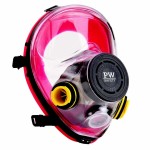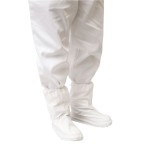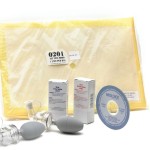
Asbestos is a dangerous material to come across, and must be dealt with in a safe and effective manner. This article should provide you with all the basics you need to know.
What is asbestos?
What does asbestos look like? Well, asbestos comes in three different colours:
- Chrysotile (white)
- Amosite (brown)
- Crocidolite (blue)

These are the main types of asbestos you will find in the workplace, although they are not always identifiable by colour alone. Amosite and Crocidolite asbestos are the two most deadly forms, but they have not been imported into the United Kingdom for over twenty years now. The use of asbestos was banned in 1985 in the UK, followed by the outlawing of Chrysotile asbestos with the exception of a few specialised uses.
What risks are there from asbestos?
There are many health risks associated with asbestos exposure, and unfortunately at the moment the majority of them remain uncurable. They are onset from inhalation of the fibres in the air and this can lead ot any of the following conditions:
- Lung cancer
- Asbestosis/Fibrosis
- Mesothelioma
At present there is no cure for any asbestos related disease. In the UK alone there are up to 3500 deaths a year as a direct result of asbestos fibre inhalation, as well as reported figures of 2700 deaths a year caused from Mesothelioma in the United States. Unfortunately it is not always easy to diagnose an asbestos related disease, as symptoms can sometimes suffer a degree of lag from first exposure to the material, to the first actual symptoms of any related disease. This has been known to vary wildly from case to case, sometimes taking as little as 15 years to impact, sometimes even taking up to 60 years before any symptoms are identifiable. A large number of people who are dying from exposure at present, were originally in contact with the material between the 50’s and 70’s – which is way before the current set of regulations were introduced in 1985 and 1999.
Although it is plausible that a repeated low level of exposure to asbestos is linked to related diseases, there is a clearly well defined link between them when exposure is increased. Although considered a dangerous material, if asbestos is left intact and undisturbed when it is come across then it is unlikely any loose fibres will get airborne. Alarmingly a high number of sufferers come from the building trades: carpenters, joiners, electricians and shop fitters all run a higher risk of exposure to asbestos.
What types of buildings are likely to contain asbestos?
Asbestos is likely to be in any building which has been built or refurbished between 1950 and 1980, also if it has a steel frame structure or if the building has been equipped with boilers and thermal insulation. An important fact to remember is that between the 50’s and 80’s is that asbestos cement was widely used as a building material, so it can even be in places you wouldn’t expect it to be, so always be diligent when working onsite to lookout for anything which may indicate this.
Where is asbestos found in buildings?
Many thousands of tonnes of asbestos have been used in the past for construction. Much of this is still there, and it can be very difficult to identify, however the most common types and uses were for the following:
Sprayed asbestos, and asbestos loose packaging
This was generally used for fire breaks in ceiling voids.
Moulded and pre-formed sprayed coatings and laggings

This was primarily applied to pipes and boilers as a thermal insulation.
Sprayed asbestos mixed with hydrated asbestos cement

This was used as fire protection for a wide number of applications such as:
- Ducts
- Firebreaks
- Panels
- Partitions
- Soffit boards
- ceiling panels
Asbestos can also be found around structural steelwork, and has also known to be found inside insulating boards and wall partitions. Asbestos cement products have been known to be compressed into flat and corrugated sheets. Theses were used widely as roofing and wall cladding, whilst other uses of asbestos cement include gutters, rainwater pipes and water tanks, and also in reinforced plastics, mastic and other various sealants.
These fibres has also been found in millboard, paper and paper products that have been used for insulating electrical equipment, as well as also being used as a fireproof facing on wood fibreboard, certain textured coatings, decorative plasters and paints, ropes and even cloth.
How does asbestos get into the body?
Asbestos can only enter the body through the nose and mouth. Even though the human body will expel most larger fibres when inhaled, far smaller ones such as those from asbestos sometimes make their way into the lower half of the lungs, where they can sit for years. On some occasions they have even breached the lining of the lungs themselves. It can also be found naturally in water and some food; however the body can deal with it when ingested in that manner.
How do I protect myself and my co-workers?

Asbestos dust can spread easily, but given the correct approach it is possible to protect yourself and your workforce in an effective manner. First and foremost you should ensure that your team is all equipped with suitable personal protective equipment and clothing, such as coveralls and respirators. Also ensure that all PPE is stored in a secure area away from all possible contaminants, and that no PPE is ever taken off site. Bare in mind when taking breaks, even for something as simple as a coffee or a quick cigarette – it’s paramount that you thoroughly wash your hands and face before you do anything, as well as at the end of the day before you leave. Also try to separate working areas from areas where you are eating and drinking.
Any materials which you plan to work on that may contain asbestos should be dampened whilst you work on them, this saturates the fibres, meaning they are less likely to become enter the air, also remember to re-dampen once in a while also. As another precaution, power tools should be omitted altogether when working with asbestos based materials. Instead; use hand tools – however tedious this may sound you ultimately have greater control over the speed of a hand tool than over that of a power tool, and a power tool creates substantially larger quantities of dust.
Any waste created whilst working with Asbestos based materials should be cleaned up as you go, and disposed of accordingly, don’t allow for debris to pile up otherwise it will dry out and if disturbed could release fibres into the air. Any waste should be contained securely in a suitable sealed container or in a heavy duty polythene bag – sealed then put inside a second bag and labelled clearly as asbestos waste. Any waste needs to be taken to a suitable facility, not a regular tip. Any dust which may still be left around can be cleared up by using a type H vacuum cleaner.
What PPE should I consider when working with Asbestos?
In order to stay protected around asbestos, you need to make sure that you have full body protection, and a respirator equipped with PP3 rated filters. Below is a small selection of products we stock which will help you stay safe.

Type 5&6 Overalls (50)
£127.92 ex VAT

Zurich Full Face Mask
£78.32 ex VAT

£75.04 ex VAT

Fit Test Kit
£133.44 ex VAT
We have also have a wide variety of EN149 respirators in stock to ensure safety when working alongside asbestos fibres, as well as other contaminants.
